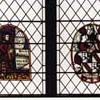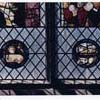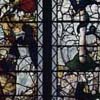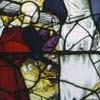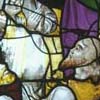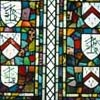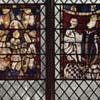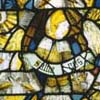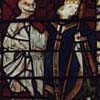Corpus Vitrearum Medii Aevi
Medieval Stained Glass in Great Britain
Your trail:
- CVMA Publications
- Norfolk: Norwich, Parish Church of St Andrew
Norfolk: Norwich, Parish Church of St Andrew
O.S. TG 232087
Document Contents
North Aisle
nIV.
2b.
Robert Gardener, mayor of Norwich, kneeling
on a yellow chequered floor wearing a soft black hat in his red
fur-trimmed aldermanic gown, facing to sinister, against a
blue-seaweed diaper dado, above which is a purple wall with a
circle-and-quatrefoil pattern. On the right beneath a leaded window
with his merchant’s mark on a shield is a blackletter inscription on
a hanging sheet perhaps of parchment: 'Roberto Gardener quo[(n)]da[(m)]
maiore huius Civitatis comodissime'. Trace-line,
matt wash, relieving. White, ruby, blue and purple glass, with
yellow stain. After 1508. Much and possibly this entire panel is of
19th-c date, but parts of the ruby gown and fur may be original.
h 0.53m, w 0.41m
NMR BB89/05676 (1987, col. print, CVMA inv. no. 003234);
DK (2007)
2c.
The arms and achievement
of Thomas Layer, mayor of Norwich in 1576, 1585,
1595, in an oval cartouche shield with plain yellow-tain border,
Quarterly 1 and 4, Per argent and sable counterchanged a
unicorn courant between three crosses crosslet, 2 and
3, Argent on a bend gules three Catherine wheels
or; at the base on a cartouche '
LAIER BVTIFANT '. Gentleman’s helm and mantling,
with crest of a horse’s head argent rising from a coronet
gules. Late 16th/early 17th-c. Winter’s drawing shows
that the fourth quarter originally had Layer’s merchant’s mark and
the word ‘ BVTIFANT ’ was missing.
h 0.56m, w 0.405m
NMR BB89/05676 (1987, col. print, CVMA inv. no. 003234); DK
(2007)
North Clerestory
NII.
The tracery lights are filled with fragments, difficult to see because of the height. It is possible that a few may be medieval. 49
A4.
Fragments,
including a gold well, the rebus of Bishop James Goldwell.
Trace-line, matt wash, relieving. White glass, with yellow stain.
c.1510 – c.1520? The other fragments appear to be 19th-c.
DK (2007)
sV.
1b. A modern roundel with the
Agnus Dei
, and a blue border containing 16th-c glass, some with
yellow stain.
NMR BB89/05671 (1987, col. print, CVMA inv. no. 003229); DK
(2007)
2–4b.
The Sacrifice of
Isaac depicted in two episodes.
50
In
the lower half of the surviving glass, Abraham and Isaac set off up
the mountain along a stony path past a house with stepped gable.
Abraham wears a white mantle with blue sleeves and tippet and a soft
purple hat; he is seen from behind, his head turned to the left. On
the hem of his mantle is 'Ave
gra[tia]
' in Renaissance
lettering.
51
Isaac follows him on his left, carrying a
faggot on his left shoulder and wearing a long hooded ruby tunic
with blue and purple sleeves and blue hose. The upper part shows a
very fragmentary scene with Isaac kneeling on a low altar on the
right, facing to sinister, and the jumbled remains of Abraham with
raised sword on the left, the angel above and the lamb
below.
52
On the
hem of Abraham’s mantle is some faded lettering, which King
interpreted as ‘Abraham’; ' aham
' is visible today. King also saw on the next fold of
the mantle ' amicus Dei
'.
53
Between
the two figures is Abraham’s purple hat. In addition to the colours
mentioned, green and blue glass are used for grass and plants, with
yellow stain on the blue; the house bottom right is in murrey glass.
Trace-line, matt wash, stippling, relieving, possible washes of thin
sanguine. c.1510 – c.1520. Cut down at the sides and the bottom
scene missing; very fragmentary in top third; many repair leads;
moderate paint loss in some areas. Graffito on piece of purple:
‘George Cobb Glazier 18 Aug. 1881’.
h 2.28m, w 0.58m (without quarry background)
NMR BB89/05669 (1987, col. print, CVMA inv. no. 003228); G.
King & Son (1965, col. trans., CVMA inv. no. 010796); DK
(2007)
1c. A roundel panel of
fragments from the Raising of the Brazen
Serpent, showing one Israelite with a turban, another
with a caul, and parts of scaly serpents, within a border of blue
fragments. Trace-line, matt wash, stippling, relieving. White and
blue glass, with yellow stain. Several repair leads across faces.
d 0.32m
NMR BB89/05671 (1987, col. print, CVMA inv. no. 003229); DK
(2007)
2–4c.
Moses proclaims the Ten Commandments to the Israelites,
who raise the brazen serpent. In the lower part are
the top parts of two well-dressed Israelites wearing Renaissance
costume. Both have ruby robes with white shoulder pieces, and that
on the right has a yellow tippet; King’s watercolour shows that they
also had white mantles when complete. Above them on the right stands
Moses holding the tablets in his left hand and pointing to the
brazen serpent with this right. He wears a purple mantle over a blue
robe. To the left of Moses stands a group of Israelites
gesticulating. In the top section on a green hill is the brazen
serpent, actually blue with yellow-stain details, hanging on a
tree-trunk with trimmed branches and a forked top, set against the
sky with trees and buildings in the background. On the tablets is an
inscription in Renaissance lettering 'TA|bV|LA|MAN|DA|TOR|VM|DEI'. Trace-line, stipple
shading, matt wash, relieving. White, blue, green, purple and
flashed-ruby glass, with yellow stain and sanguine. c.1510 – c.1520.
King’s watercolour shows that the bottom quarter of the panel,
depicting the Israelites attacked by serpents, is missing (a few
fragments are leaded into 1a). Moses’ head and tippet missing;
section cut out between 2b and 3b; top missing and made up with
fragments from the window; a church to the left of the hill is
missing and patched with fragments; many repair leads; some paint
loss, especially on the tablets.
h 2.28m, w 0.58m (without quarry background)
G. King & Son (1965 col. trans., CVMA inv. no.
010797); NMR BB89/05669 (1987, col. print, CVMA inv. no. 003228); DK
(2007)
sVII.
1b.
Arms of the Grocers’
Company, Argent a chevron gules between
nine cloves proper. The field has a diaper of relieved
circles. Trace-line, thin matt wash, relieving. White and ruby
glass. c.1510 – c.1520. Ruby flash worn.
h 0.18m, w 0.135m
NMR BB89/05674 (1987, col. print, CVMA inv. no. 003233); DK
(2007)
2b.
Three
shields set on a rectangular panel of fragments. The
top and bottom shields bear the merchant’s mark of Nicholas Colich,
and the middle one the arms of the Grocers’ Company, as in 1b of
this window.
54
Trace-line, thin matt wash, relieving.
White and ruby glass. c.1510 – c.1520. Paint loss on the bottom two
shields; repair leads, particularly numerous on the top shield. The
fragments have a double fillet around them and consist of drapery,
ornament and diaper in white, blue, ruby, purple, pot-yellow and
green glass. Trace-line, matt wash, relieving, yellow stain. c.1510
– c.1520. Generally good condition.
h 0.90m, w 0.56m
G. King & Son (1965 col. trans., CVMA inv. no.
010794 (reversed)); NMR BB89/05674 (1987, col. print, CVMA inv. no.
003233); DK (2007) DK (2007)
3b.
Arms of the Grocers’
Company, Argent a chevron gules between
nine cloves proper. The field has a diaper of relieved
circles. Technique as 1b. Some paint loss on diaper, repair leads.
h 0.18m, w 0.135m
NMR BB89/05674 (1987, col. print, CVMA inv. no. 003233); DK
(2007)
1–3c. Arms of the Grocers’ Company. As
1b, with one repair lead.
NMR BB89/05674 (1987, col. print, CVMA inv. no. 003233); DK
(2007)
2c.
Three
shields set on a rectangular panel of fragments. The
top and bottom shields bear the arms of the Grocers’ Company, as in
1b of this window. The middle shield has the merchant’s mark of
Nicholas Colich, as in 2b. Technique as before. c.1510 – c.1520.
Paint loss on top and middle shield, repair leads, especially on
middle shield. Fragments as 2b.
h 0.90m, w 0.56m
G. King & Son (1965 col. trans., CVMA inv. no.
010794 (reversed)); NMR BB89/05674 (1987, col. print, CVMA inv. no.
003233); DK (2007)
sVIII.
1b.
Shield with arms of St
Michael the Archangel, Gules a cross flory
argent. White and ruby glass. c.1510 – c.1520. Repair
leads.
h 0.20m, w 0.14m
NMR BB89/05673 (1987, col. print, CVMA inv. no. 003231); DK
(2007)
2b.
Fragments, including
parts of several angels. The central feature is
part of a composite feathered angel standing holding a curved scroll
with the text in blackletter 'Salva
nos'.
55
The angel wears an ermine tippet and a
segmented belt with pot-yellow wings against a blue background.
Trace-line, thin matt wash. White and blue glass, with yellow stain.
15th-c and 19th-c. The wings, upper body and background may belong
together; the head is from a 19th-c angel standing against
micro-architecture and the scroll was originally held by a
larger-scale figure. Above and below are parts of ten angels mainly
dressed in white surplices with yellow sleeves, which were probably
demi-figures, as the two lower ones emerge from blue cloud.
Immediately below is part of an angel playing a drum, to the right
of and above which another holds a crown, and to the left of and
below a third plays a wind instrument, perhaps a cornet. Trace-line,
thin matt wash, relieving. White and blue glass, with yellow stain.
c.1510 – c.1520. The other angels are in a different style. To the
left and right are parts of angels with arms raised, on the left in
prayer position and to the right across the chest; bottom right is a
harping demi-figure of an angel; at the top, one with hands raised,
flanked on each side by a harping angel. Trace-line, matt wash,
smear shading, relieving. White and blue glass, with yellow stain.
c.1510 – c.1520. All are headless, and there is some paint loss.
Other fragments making up this panel include feathers and parts of
clouds emitting a glory in the same style as the latter group of
angels; blue glass, white drapery and part of a pomegranate, the
badge of Catherine of Aragon (c.1510 – c.1520); a piece of blue
seaweed diaper (15th-c, probably not from St Andrew’s); ruby, blue,
yellow, green and purple glass with plants, feathers, foliage and
ornament in the borders (c.1510 – c.1520), all in excellent
condition.
h 0.88m, w 0.57m
G. King & Son (1965 col. trans., CVMA inv. no.
010795); NMR BB89/05673 (1987, col. print, CVMA inv. no.003231); DK
(2007)
3b.
Shield with the arms of
St Catherine, Gules in fess a Catherine
wheel or in pale a sword point downwards, pommel and grip of the
second. Trace-line, matt wash, relieving. White and
ruby glass, with yellow stain. c.1510 – c.1520. Some paint loss,
several repairs leads.
h 0.20m, w 0.14m
NMR BB89/05673 (1987, col. print, CVMA inv. no. 003231); DK
(2007) h 0.20m, w 0.14m
1c.
Shield with the arms of
St Andrew, Gules a saltire vert.
Ruby and green glass. c.1510 – c.1520. Repair leads.
h 0.20m, w 0.14m
NMR BB89/05673 (1987, col. print, CVMA inv. no. 003231); DK
(2007)
2c.
Panel from the Dance of
Death. On the left Death as a skeleton facing right
and dressed in a shroud strides towards a bishop on the right,
grasping his right hand. The bishop wears a mitre, blue cope and
purple dalmatic with a green fringe and stands holding a crozier in
his left hand as he turns away from the skeleton. Both stand on a
chequered floor against a ruby cloth hanging with a relieved pattern
and beaded white hem with yellow stain. Trace-line, stipple shading,
relieving. White, ruby, blue, green and purple glass, with yellow
stain and sanguine. c.1506 – c.1510. The bottom right section
including the crozier is patched with fragments, probably from other
panels in the series and the body of the skeleton and ruby
background are muddled with several repair leads. Light to medium
paint loss on skeleton, floor, cope and hanging; many repair leads.
Made up with fragments at the top and down each side, including a
piece of rod-and-leaf border (15th-c), and blue drapery, plain ruby,
green and blue and white glass with ornament (c.1506 – c.1520).
h 0.88m, w 0.57m
NMR (col. print, CVMA inv. no. 003230); NMR BB89/05673
(1987, col. print, CVMA inv. no.003231); DK (2007).
3c.
Shield with the arms of the See of
Canterbury, Azure a pallium argent charged with
five crosslets fitchy sable surmounting a pastoral staff headed
by a cross patty or. Trace-line. White and blue glass,
with yellow stain. c.1510 – c.1520. Paint loss on pallium and repair
leads.
h 0.20m, w 0.14m
NMR BB89/05673 (1987, col. print, CVMA inv. no. 003231); DK
(2007)
South Clerestory
SII.
A1.
Fragments, including a large white crown
with yellow stain. 16th-c? The rest appear to be
19th-c.
56
SVII.
D1.
Merchant’s mark of Robert Aylmer, mayor
1481 and 1492, with plain yellow-stain border. Trace-line. White
glass. c.1506 – c.1520. Cracked.
DK (2007)
E1.
Eyelet with blue glass. May not be in
situ. c.1506 – c.1520.
DK (2007)
E2.
Eyelet with ruby glass. May not be in
situ. c.1506 – c. 1520.
DK (2007)
SVIII.
D1. As SVII D1.
DK (2007)
SX.
D1. As SVII D1. Segment bottom left missing.
DK (2007)
SXI.
D1. As SVII D1. Cracked, some paint loss.
DK (2007)
E1.
Eyelet with sunburst. White glass with
yellow stain. c.1506 – c.1520. Dirty.
DK (2007)
Footnotes
- 49.
- The same applies to SII; see the earlier comments on the work of J. & J. King in the church. Return to context
- 50.
- Harrod (1855) saw three episodes, beginning at the bottom with Abraham with Isaac and his servants preparing for the journey. Return to context
- 51.
- G. A. King saw ‘Ave gratia plena’; King 1914, p. 286. Return to context
- 52.
- King’s watercolour shows the upper scene complete. Abraham looks up at the angel, holding the scabbard of his sword with his left hand and the sword over Isaac’s head with his right, while the angel on a cloud grasps the blade of the sword. Harrod (1855) says that ‘the ram appears to replace Isaac on the altar’, but it is hard to reconcile this statement with King’s drawing and the surviving glass. Return to context
- 53.
- ‘Abraham amicus Dei’ is in James II, 23; the passage refers to ‘et tu Israhel serve meus Iacob quem elegi semen Abraham amici mei’ in Isaiah XLI, 8. Return to context
- 54.
- Nicholas Colich was mayor in 1497 and was buried here in 1502, giving 50 marks to the rebuilding. He probably paid for the glazing of the north clerestory; see the introduction. Return to context
- 55.
- The first words of the antiphon ‘Salva nos Christe Salvator per virtutem sanctae cruces, qui salvasti Petrum in mari miserere nobis’, sung at the feast of the Exaltation of the Holy Cross; Procter and Wordsworth 1886, III, col. 815. Return to context
- 56.
- See note 49. Return to context
